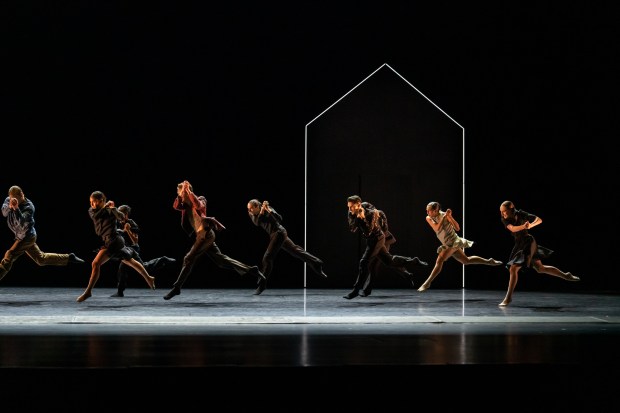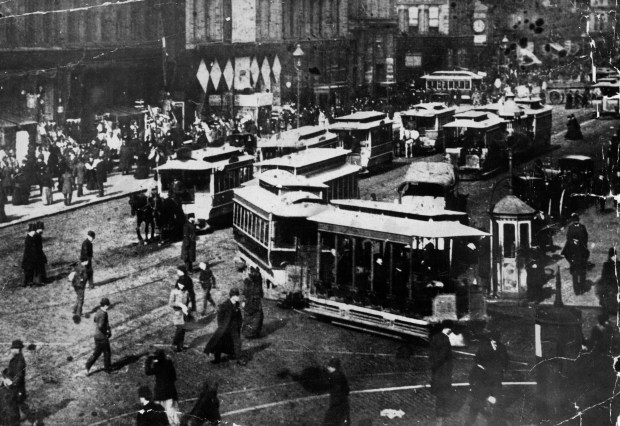It’s not a time capsule. Hubbard Street Dance Chicago’s revival of Ohad Naharin’s “Black Milk” after more than 20 years in the vault is more a wink and a nod. After several seasons dibble-dabbling across the aesthetic spectrum — from Bob Fosse to Aszure Barton and everything in between — the Winter Series on now at the Harris Theater returns to familiar ground. That’s not to say the Hubbard Street of 2002 was somehow better; rather, artistic director Linda-Denise Fisher-Harrell projects confidence in the 47-year-old institution, as if to say, “Yeah, we still do that, too.”
Naharin first created “Black Milk” in 1985 for Israel’s Kibbutz Contemporary Dance Company, later adding it to a compilation of seven dances called “Minus One.” It’s miles away from “Minus 16,” Hubbard Street’s first-ever acquisition by the ground-breaking choreographer, which propelled the company into a new era near the end of founder Lou Conte’s tenure as artistic director. “Black Milk,” acquired two years after “Minus 16,” is pre-Gaga, the counter-technique Naharin developed, which has informed decades of dancemaking. Here, he draws from his background in the Martha Graham Dance Company and even the School of American Ballet, asking much of “Black Milk’s” five bare-chested dancers (which on Thursday included Aaron Choate, Elliot Hammans, Jack Henderson, Andrew Murdock and David Schultz). “Black Milk” is thus just as hard as anything else Naharin’s made, if less idiosyncratic — the stoicism of those techniques busted open with a deep-kneed, guttural vocabulary and thrilling partnering.
Then there’s the symbolism. Naharin offers little context apart from a silver pail of dark sludge methodically smeared across the dancers’ faces, chests and thighs. Schultz is the quasi-protagonist, here, often moving separately from the rest, seemingly resistant to indoctrination into whatever discipleship they’re apparently part of. By turns elegant and feral, there’s a sense these dancers have each other’s backs, even as Schultz breaks away to wash himself clean. But the vibe is more “Get up, you fool!” than “You got this, friend.”
It’s a piece that’s aged well, even when put against three striking others from the “now.” James Gregg makes his Hubbard Street debut with the evening’s only world premiere, called “Within the Frame.” The title is both a literal and figurative exploration, with four dancers spending most of their time confined to a square, white section of floor acting as the quartet’s sandbox. They’re rarely onstage altogether; Gregg was originally tasked with making a duet but apparently couldn’t help himself. Indeed, “Within the Frame” doesn’t feel particularly communal in the way long, deep engagements do. Rather, it comes across more like the solidarity and community felt among strangers on a train — people with a common goal and, maybe, nothing else in common. Gregg prescribes periodic breaks from his luscious phrases; the dancers to step out completely or simply turn away and put their hands in their pockets. (Pockets! In dance costumes!!). Gregg’s boundary-busting aesthetic draws from a wide variety of styles, honed from a storied performance career that started in Chicago. In a way, “Within the Frame” interrogates that collection of experiences spanning jazz, contemporary, hip hop and vogue, but it’s not navel-gazing. It feels for and about the quartet (Dominick Brown, Choate, Michele Dooley and Cyrie Topete), who thrive in “Within the Frame’s” gorgeous, monochromatic environment — pro forma for Gregg — built by Slick Jorgenson (lighting) and Hogan McLaughlin (costumes) and surrounded by a similarly multilayered score by Ben Waters.
Hubbard Street alums Alice Klock and Florian Lochner, collectively called FLOCK, crafted “Into Being” last year for Hubbard Street’s series at the MCA. Somehow, in the cavernous-by-comparison Harris Theater, it feels more intimate, perhaps because of its placement in an otherwise chilly, mostly black-and-white program. “Into Being” radiates complexity and warmth, and not just because of the bronze and gold separates its five dancers wear. It’s also our first real glimpse at dancer Bianca Melidor, an expat of Dallas Black Dance Theatre who joined the company this fall. Though early in her career, Melidor already brings a wealth of maturity and nuance to her long, luxurious solo, a mirage placed midway through FLOCK’s mostly meditative, meticulously crafted world.
Then there’s “Impasse,” a fantastically wacky full company piece closing the program. Like “Into Being,” “Impasse” premiered at Hubbard Street last year and hasn’t yet gotten the play time it deserves. Part jazz funeral, part “Appalachian Spring,” Inger sends Schultz, Henderson and Simone Stevens in and out of a 2-D house positioned upstage multiple times. They seem shocked — appalled even — by what they encounter, which gets weirder every time: a mob of black-clothed people who seem to be having a better time than them, then a grab-bag of bizarre characters ranging from a crowned shirtless prince to a clown that’s a little too close to Rob Zombie’s Captain Spaulding for comfort.
Maybe it’s Narnia. Or perhaps what Alice finds beyond the looking-glass. Whatever it is, it’s fleeting. A white-streaked black backdrop descends on this wonderful world, forcing our three adventurers to squeeze underneath, barely managing to escape. It’s not immediately clear why they’d want to leave such a weird and wonderful joy bomb, a hesitancy sure shared by every audience member that night.
Lauren Warnecke is a freelance critic.
Review: Hubbard Street Dance Chicago Winter Series (4 stars)
When: Through Sunday
Where: Harris Theater for Music and Dance, 205 E. Randolph St.
Running time: 2 hours, 10 minutes with 2 intermissions
Tickets: $46-$121 at 312-334-7777 and harristheaterchicago.org




